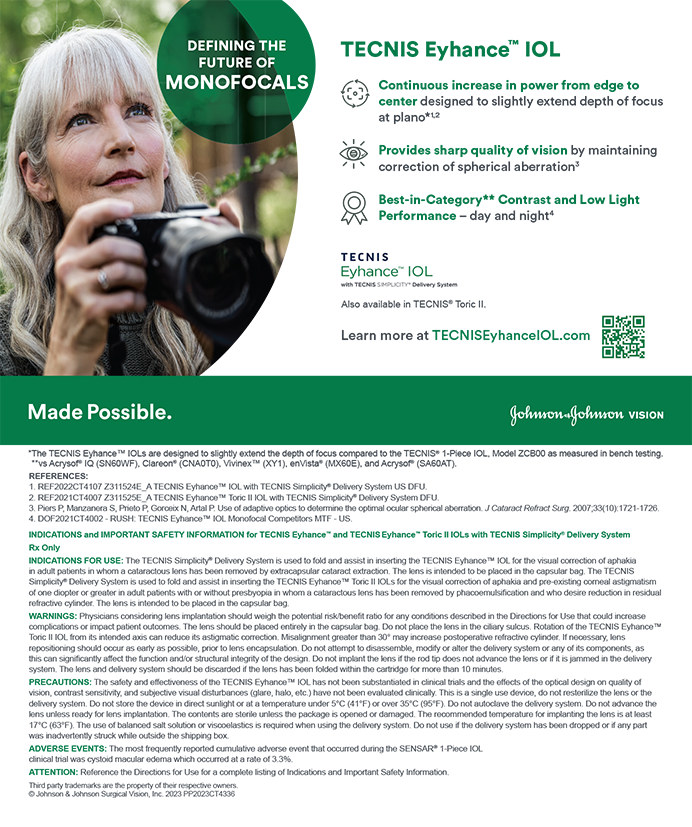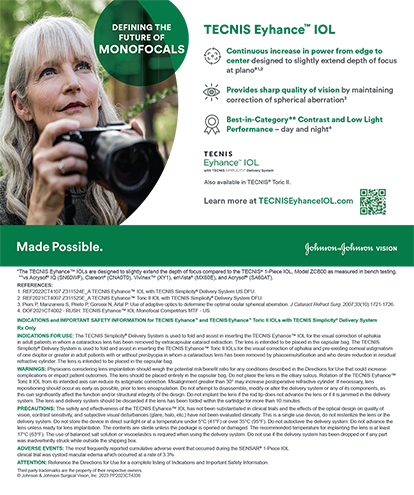
The refractive surgery ecosystem is in many ways similar to the ecosystem of Earth. Like the environment of Earth, the refractive surgery ecosystem is fragile and easily damaged by pollution and misuse. As a result, the refractive surgery marketplace can be difficult to navigate.
Some abuses are obvious. There are those who are vocally against refractive surgery, which is to be expected in any human endeavor. There have been media efforts, both with editorial content and advertising, that have misinformed the public through either inflated claims of benefits or sensationalized reports of risks.
Refractive surgeons also have some culpability in damaging the ecosystem. In efforts to market their own practices, surgeons sometimes engage in campaigns with a negative slant—attacking the market rather than shaping it. No doubt negative campaigning has its place, but it is our belief that, in the fragile refractive surgery ecosystem where patients have only one set of eyes, negativity is not constructive.
Can negative campaigns work? Yes, they can: Negative political campaigns have been effective, as have food branding efforts such as Campbell’s Soups attacking Progresso, Domino’s Pizza attacking Subway, or the Pepsi Challenge (Pepsi versus Coca-Cola).1 But when a patient is presented with a negative marketing message regarding refractive surgery, most reasonable-minded prospects are likely to react negatively, by either delaying or abandoning the decision-making process.
In this article, we discuss how to shape the marketing content that your prospective patients will encounter when making a decision about laser vision correction (LVC). Is the messaging valid, educational, and instructive? Or is it confusing, conflated, and negative? We share ideas regarding what creates a constructive context rather than a confusing or negative perception of refractive surgery and its potential impact on patients’ lives. We believe that, by going positive, refractive surgeons can help the fragile refractive surgery ecosystem not just survive, but thrive.
WHO BENEFITS FROM MARKETING?
Refractive surgeons often express disappointment that refractive surgery device manufacturers don’t invest in marketing refractive surgery on a national consumer scale. After all, these companies have an interest in creating consumer demand. But, although device manufacturers do spend money on strategic marketing, it would not be effective or cost-effective for each manufacturer to engage in national campaigns to increase awareness of its own specific technology. The manufacturer’s interest is in creating demand for its brand, which is why these companies focus their marketing efforts on surgical practices.
A national marketing effort around one brand of LVC technology might encourage consumer interest in refractive procedures in general, but the resulting demand might not extend to practices with technologies other than the brand advertised. Because of this, by default, patient education, messaging, and marketing to the public has been left to local private practices and regional or nationwide corporate laser centers.
UNPRODUCTIVE MARKETING MESSAGES
For the purposes of this article, we are making general statements about marketing messages. The medium—whether it be advertising, social media, website content, an interview for a broadcast news segment, or a contributed article—matters less than the message. In our view of the consumer landscape, as informed by market research conducted by the Refractive Surgery Council (RSC), there are several forms of nonconstructive messaging.
One is unrealistic pricing, often presented as part of a bait-and-switch campaign. Lowball LASIK pricing used to be $299 per eye, then $250 per eye, and most recently $199 per eye. In reality, the average actual cost of LASIK in 2018, according to Market Scope, was more than $2,200 per eye.
We know that most patients cannot qualify for the stringent, narrow correction parameters often attached to the mythical $199 price tag. This type of promotion, therefore, brings prospects into the practice based on unrealistic and unsound expectations. The effect on the refractive ecosystem is confusion among patients about the cost, value, and credibility of the LVC profession and industry.
Escalating technology messaging is also not helpful for patients making a decision; when presented with too many decisions to make, prospects are likely simply not to decide at all. Market strategies built on dueling technology platforms do little to assist in building patient confidence when making a choice. There are many examples of this approach. Practice A states that its laser pulses at 100 times per second. The following week, Practice B states that its laser pulses at 200 times per second. This cycle is easily fed by all of the innovation in LVC, but, ultimately, the patient freezes in confusion or in fear of missing out on the latest advances—which may or may not be appropriate to that patient’s specific needs.
The most destructive type of negative marketing messaging, in our opinion, occurs when one procedure is denigrated in comparison with another. The reality is that most LVC prospects do not understand the differences among procedures. In fact, most believe that they are all some form of LASIK. When comparative marketing messages about procedures are used to differentiate a practice, therefore, the likely result is confused or apathetic prospects.
This is doubly unfortunate because it is clinically evident from peer-reviewed reports that the available corneal laser procedures—LASIK, PRK, and SMILE—all produce excellent and essentially equivalent visual acuity results.2 It is, therefore, not only unproductive but also untrue to disparage one laser procedure and claim superiority for another.
GOING POSITIVE
Going negative with marketing campaigns is easy. However, this lazy man’s approach is dangerous, based on our analysis of prospective LASIK patients’ concerns and questions. Going positive in messaging requires more work and creativity. Choosing the role of educator rather than marketer is a great place to start. Simply and directly answering the questions that prospects are likely to ask can serve as the foundation of a positive message platform.
The RSC engages in proprietary market research, gathering and analyzing from online sources the unprompted expressions and sentiments of consumers around LVC. As a result, the RSC has amassed insights into the opinions, questions, and concerns expressed by prospective LVC patients. For practices that are interested in engaging in positive marketing messaging a few topics to consider are listed here.
Surgeon Expertise and Voice of Authority
Presenting your credentials and experience in a transparent way fosters a sense of trust and respect among LVC prospects. Include references to your board certifications, training, research experience, procedure volume, and outcomes. These should be your points of distinction rather than price or technology.
Incorporate patient education information into your editorial output on blogs or social media channels. Through the RSC Verified program, practices can access a library of unbranded, clinically valid, relevant material that can easily be slotted into a practice’s editorial calendar. (Sign up for RSC Verified at bit.ly/RSCVerified.)
Word of Mouth
The best marketing for a practice comes from satisfied patients. Having a process for gathering testimonials and reviews and maintaining a bureau of past patients willing to speak with prospects are good, productive, and positive ways to support a marketing campaign.
Service Offerings
LVC prospects are looking for something to help them select a surgeon. Sometimes, that thing is unquantifiable. You never know what will make a prospect more comfortable with your practice over another. We recommend giving prospects a sample of the experience of your practice: What can they expect from first contact through postoperative care and ongoing eye care?
Your service profile should also include a thorough description of the LVC options you offer, with an emphasis on the risks and benefits of each, but without comparing (and inadvertently disparaging) them. Patient information should focus on the specific patient profile and candidacy requirements for each procedure the practice offers. Having LVC options means there is a greater chance that you offer a procedure that can help any given patient; this should be supported rather than undermined with competitive or comparative messaging.
A POSITIVE APPROACH
We firmly believe that an informed patient is, ultimately, a more satisfied patient with better outcomes, which is important to the profession and industry as a whole. We recommend that surgeons who are interested in taking a positive approach with their marketing efforts should seek out the resources available from RSC. Together, we can help the refractive surgery ecosystem grow and flourish.
1. Denari T. Negative Ads Might Just Be Positive for Your Brand: Four Reasons Why Marketers Should Not Rule Out Negative Ads. Ad Age. November 04, 2014. https://adage.com/article/agency-viewpoint/negative-ads-positive-brand/295692/. Accessed July 24, 2019.
2. Wen D, McAlinden C, Flitcroft I, Tu R, et al. Postoperative efficacy, predictability, safety, and visual quality of laser corneal refractive surgery: a network meta-analysis. Am J Ophthalmol. 2017;178:65-78.




